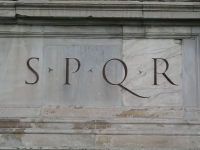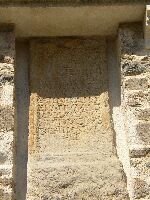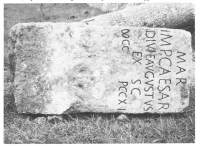


Administration of the aqueducts
Until the last century of the Republic the censors had charge of all the aqueducts (Livy, 39.44), and built three of the four republican aqueducts. The censors had to contract out and inspect the work. The task of inspection might be delegated to an aedile, who oversaw the distribution of water in the town. Then the aqueducts were for a short time under the administration of the aediles and quaestors. The quaestors acted in their capacity as treasurers. The aediles would deputise two locals on each street to police their neighbourhood fountain. During the periodic vacancy of the censorship, questions of jurisdiction sometimes fell to a praetor to decide (Aicher, 1995:23).Cura Aquarum
This lasted until the reign of Augustus, who instituted a new a complete system of management directed by a Curator Aquarum who was appointed for life.)1 It was an office of great dignity, resembling in function that of a Curator Viarum or Frumenti. The first Curator Aquarum was, in effect, Marcus Agrippa, who held the office from 36 BC until his death in 12 BC (Middleton, 1892:317). He had at first acquired the office of the aedileship in part to give his intervention in the water-supply some constitutional precedence. Once out of office, he retained his position as chief supervisor of the aqueducts. The senate acknowledged the office of Curator Aquarum the year after Agrippa's death, in 11 BC (Aicher, 1995:23). The Curator Aquarum managed the public water supply, and also adjudicated over right-of-way disputes and cases of water-law violations.Staff
He managed a number of minor officials and personal attendants (apparitores) to assist with these tasks, such as secretaries (scribae libarii), ushers (accensi), criers (praecones), three public slaves (servi publici), engineers (architecti) and two lictors when outside the gates of Rome. The public office of the Curator was called the Statio Aquarum. A number of clerks were attached to it, known as the Tabularii Stationis. Other subordinate officials of relevance were the two assistants, Adiutores, men of senatorial rank, one Procurator Aquarum, usually an Imperial Freedman, and a Tribunus Aquarum. The artisans who worked under the Curator were classed as belonging to the Familia aquaria publica and Familia aquaria Caesaris. These included Aquarii or Villici, presided over by a Praepositus, who made and laid the lead supply pipes; Libratores, who measured levels of the water; Castellarii, who kept the castella or reservoirs in order; Circitores, inspectors of the works; Silicarii, who took up and relaid the silex (lava) street pavement, when mains were laid or repaired; Tectores, tilers, and other workmen, such as bricklayers, masons, Pestatores, pottery crushers (testae tunsae), to make the opus signinum of lining the channels and reservoirs.)2familia publica
Agrippa bequeathed to his emperor a vast fortune, including a private crew of 240 slaves that had been employed in the maintenance of the city's aqueducts. Augustus gave these to the state, and the Senate's legislation organised them into a familia publica, in essence a slave gang supported by public funds and under the direction of the curator (Aicher, 1995:23). These were known as the aquarii.familia caesaris
Claudius (d. AD 54) introduced reforms in line with his policy of concentrating authority in the civil service directly under his authority. He created the Procurator Aquarum post and appointed men to it. Trajan and his successors were to appoint the occasional equestrian to the post. Claudius added another 460 slaves to the aquarii. They were now called the familia Caesaris and were controlled by the procurator.Curatorship
The curatorship of the aqueducts might have been the most prestigious non-political office in ancient Rome. Its holders were generally senators who held distinguished positions both before and after their terms as curator. A curator received many honours extended to other high offices of the Roman state. These included certain immunities of office, and the right to wear the toga praetexta. The curator was appointed by the emperor and served for an indeterminate amount of time, ranging from a few months to many years. The post may have been left unfilled for some period of time, and there is some evidence that two men may have held it from time to time. It was not meant to be a full-time occupation. A resolution of the senate, as quoted by Frontinus (101), prescribes that the curators devote one quarter of the year to the public office (Aicher, 1995:24).Headoffice
The physical location of the statio aquarum is not known, if there was one. At the end of the second century AD the title curator aquarum et Minuciae appears, indicating that the same official oversaw the water-supply and distribution of free grain. The latter occurred from the Porticus Minucia, which was probably located in the Campus Martius east of the four Republican temples in Largo Argentina (Aicher, 1995:25). Inscriptions from Constantine's reign found on a statue in some rooms near the spring and temple of Juturna in the Forum have led to speculation that the office was relocated to the forum in the 4th century. Bruun argues against the existence of and special physical office at all (Bruun, 1991). Richardson states that the speculation is probably accurate (Richardson, 1992).Considering how copious the water supply was in Rome, the silicarii must have been constantly at work, pulling up and relaying the pavements of the streets when the mains or their branches needed repair. In some cases, especially for more important streets, the Romans formed tunnels in which the pipes were laid, and could thus be repaired without breaking up the street. This wise policy has not been widely adopted in modern cities (Middleton, 1892:318). It is possible that the Roman pipes, made from thick lead, was more robust than modern pipes and thus required less frequent repairs.
There is evidence that the construction of new aqueducts was carried out in part by public contractors (Redemptores operum publicorum).
Law
The reforms of 11 BC simplified the administration of the aqueducts. A law was passed requiring a clear space of 15 Roman feet (4.5 m) to be maintained on each side of arcades and substructions, and 5 feet (1.5 m) on each side of a subterranean channel. This was to ensure ready access to the channel, and to avoid damage caused by tree roots. Tombs and other edifices were also prohibited from encroaching on the space above channels which courses were marked with boundary stones called cippi (singular: cippus). A second law required that owners of adjacent land supply construction material at a fair price, and allow construction and repair crews right-of-way to the channel (Aicher, 1995:25).A Republican law stipulated a fine of 10,000 sesterces for anyone who polluted a a public fountain. The aediles appointed two men on each street as caretakers and watchmen of the fountains. Augustus imposed a 10,000 sesterces fine on anyone who planted trees or shrubs in the clear zone around aqueducts. This fine would be divided, half going to the state, and half going to the person whose information led to the conviction. A fine of 100,000 sesterces was imposed on anyone who wilfully destroyed any aqueduct structure (Aicher, 1995:26).
From: Evan J. Dembskey's thesis The aqueducts of ancient Rome
)2 Immense quantities must have been used. The great heap of broken pottery (mostly from amphorae from the ships) called Monte Testaccio, south of the Aventine Hill, was very likely used for this purpose.